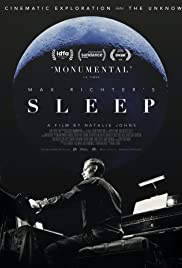
MAX RICHTER’s SLEEP
UK, 2019, 99 minutes, Colour.
Directed by Natalie Johns.
No, this is not a documentary about the sleeping habits of Max Richter. Rather, it is something of a portrait of Max Richter himself but one more, a focus on his composition, Sleep.
Max Richter was born in Germany but is an international composer and performer. His IMDb credits list indicates a range of compositions as well as the scoring of films and television series.
Sleep is a musical composition but also its performance is an event. And that is how the film begins, the introduction to a performance of Sleep, in the Grand Park of Los Angeles (with some glimpses of the performances in Amsterdam, in the UK, and in the Sydney Opera House). We discover that Sleep is an eight hour composition and performance.
We see audiences gather at the Grand Park, allotted cots available for people who want to lie down, people bringing pyjamas and blankets, settling into the cots. There are all talking heads, a range of people who indicate why they are coming to this performance and what they might expect. For the first 10 minutes or more of the film, the audience settles down and the performance begins, very quietly, the music in the background, lulling, soothing…
Then the documentary moves into interviews with Max Richter himself, the great support he has from his wife, interesting information and comments from her. We see them together, at home, ordinary sequences.
And, the rest of the film is an intercutting between the portrait of Richter and the performance of Sleep. The music plays in the background, quietly, Richter at the piano, chamber music with six performers, solo violinists, and a singer. And there is a synthesiser on stage blending the musical experience.
The aim of the experience and its art is for people to move into restful consciousness, to sleep itself, perhaps to dream, different stages of awareness, waking, resting, sleeping again, the whole performance starting at 10 PM, moving to early dawn and sunrise and the beginning of activity in the city, coming to an end to begin the day at 6 AM.
The music style is classical, generally slower and quieter, even inducing for the film audience to nod off…
For audiences who want narrative in their films, it is minimal here. For audiences who want a different cinematic experience, aural and visual, this one is different.